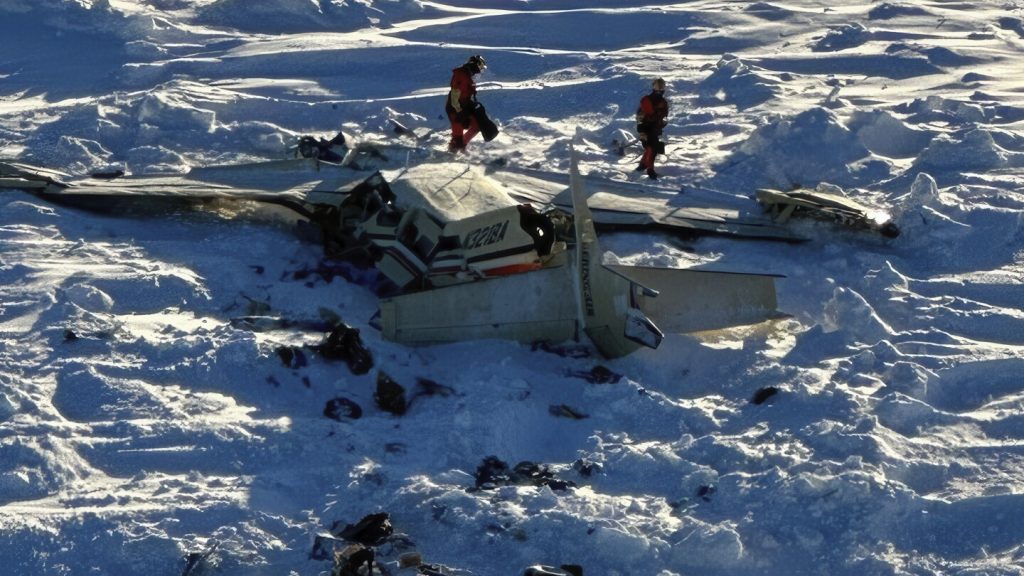Tragic Plane Crash in Alaska Claims 10 Lives, Recovery Efforts Complete
Recovery Efforts Amidst Harsh Winter Conditions
On Saturday afternoon, the Nome Volunteer Fire Department announced that the remains of all 10 individuals who perished in a tragic plane crash on the Bering Sea have been recovered. The small Bering Air plane, a single-engine turboprop, went missing on Thursday while en route from Unalakleet to Nome. Despite the challenges posed by drifting sea ice and an impending winter storm, recovery crews worked tirelessly to retrieve the bodies before harsh weather conditions worsened. The aircraft, still on a drifting ice floe moving approximately 5 miles per day, remains unrecovered, but the focus for now is on bringing closure to the families of the victims.
The crash, one of the deadliest in Alaska in 25 years, occurred under unclear circumstances. The plane was found the day after it disappeared, with no survivors. National Transportation Safety Board (NTSB) Chair Jennifer Homendy emphasized that investigators are committed to determining the cause of the crash, with the ultimate goal of improving aviation safety in Alaska and across the U.S.
Grief and Resilience in the Community
The loss of life has sent shockwaves through the small, tight-knit communities of western Alaska. Among those killed were Rhone Baumgartner and Kameron Hartvigson, who had traveled to Unalakleet to service a critical heat recovery system for the local water plant. Their contributions to the community were immeasurable, and their deaths, along with the other victims, have left a profound void. David Beveridge of the Alaska Native Tribal Health Consortium described the loss as a heartbreaking tragedy that will be felt across the state.
The pilot, 34-year-old Chad Antill of Nome, was also among the victims. The other passengers ranged in age from 30 to 58 years old. The flight was a routine commuter trip, a common mode of transportation in Alaska’s vast and sparsely populated regions. U.S. Sen. Lisa Murkowski expressed her devastation, stating, “It’s hard to accept the reality of our loss.” Nome Mayor John Handeland, choked with emotion, highlighted the strength of the community, emphasizing that residents would come together to support each other during this difficult time.
Investigating the Cause of the Crash
The NTSB is leading the investigation into the crash, with a team of nine experts en route to the scene. The aircraft was found about 30 miles southeast of Nome, on unstable, slushy sea ice. Radar data indicates that the plane experienced a rapid loss of elevation and speed around 3:18 p.m. on Thursday, but the exact cause remains unknown. Coast Guard officials noted that no distress signal was received from the plane’s emergency locator transmitter, which typically activates automatically in the event of a crash.
Weather conditions at the time of the crash were challenging, with light snow, fog, and temperatures around 17 degrees Fahrenheit. A winter weather advisory was issued for the region, with snow and winds up to 45 mph expected, further complicating recovery efforts. The crash marks the third major aviation incident in the U.S. in just over a week, following a collision between a commercial jetliner and an Army helicopter near Washington, D.C., and a medical transport plane crash in Philadelphia.
Aviation in Alaska: A Vital but Risky Lifeline
Flying is a essential mode of transportation in Alaska, where vast distances and limited infrastructure make air travel the primary means of connecting remote communities. Bering Air, the airline operating the ill-fated flight, serves 32 villages in western Alaska, providing twice-daily scheduled flights to many destinations. The company described the tragedy as “heartbreaking” and expressed its commitment to supporting the affected families and cooperating with authorities.
The crash has once again highlighted the risks associated with aviation in one of the most challenging environments in the world. Alaska’s harsh weather conditions, remote locations, and reliance on small aircraft make flying inherently risky. Yet, for many residents, it is a necessary part of life, connecting them to essential services, family, and the outside world.
Remembering the Victims and Honoring Their Legacy
The victims of the crash included individuals who played vital roles in their communities. Baumgartner and Hartvigson were dedicated to ensuring the water plant in Unalakleet functioned properly, a critical service for the health and well-being of the residents. Their work was emblematic of the quiet dedication and resilience that defines life in rural Alaska.
The people of Nome and Unalakleet are coming together to mourn the victims and support their families. Prayer vigils were held in Nome, and community members are offering emotional support during this grieving process. The tragedy serves as a poignant reminder of the sacrifices made by those who live and work in Alaska’s remote regions, and the profound impact their losses have on the tight-knit communities they serve.
Moving Forward: Learning from Tragedy
As the investigation into the crash continues, the focus will be on understanding what went wrong and how future tragedies can be prevented. The NTSB’s findings will be crucial in identifying safety improvements for Alaska’s aviation industry, which is vital to the state’s connectivity and economy. In the meantime, the people of Alaska are mourning the loss of 10 lives and honoring their memories.
The resilience of Nome and its neighbors will undoubtedly shine through in the days ahead, as they come together to heal and rebuild. While the pain of this tragedy will linger, the strength of the community offers hope for the future. As Alaska moves forward, it does so with a renewed commitment to safety and a deep appreciation for the sacrifices made by those who keep its remote regions connected.












